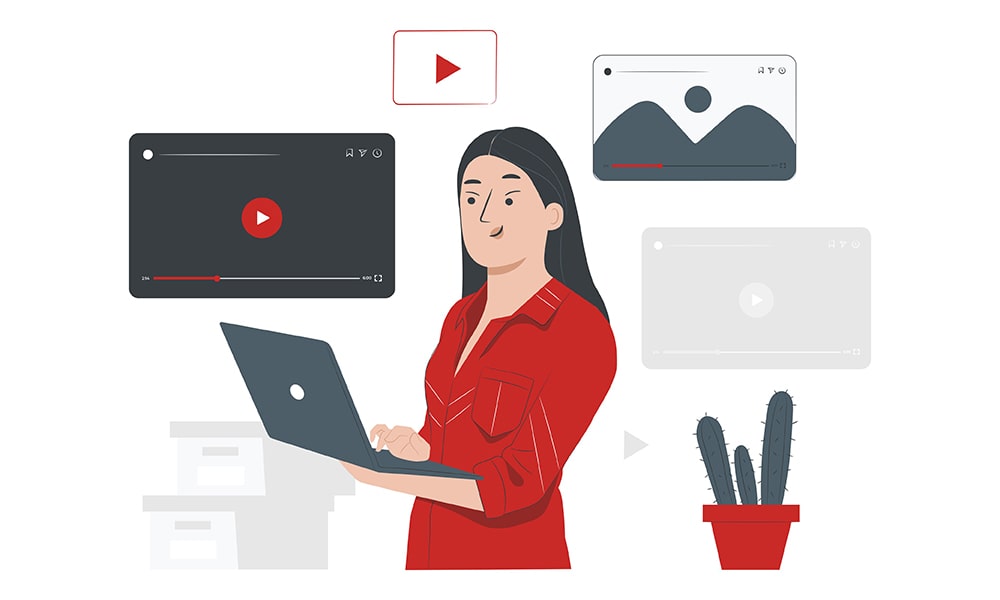YouTube has now surpassed Facebook in popularity and the appeal of video content is set to grow, with recent research finding that the majority of 18–49-year-olds now prefer video content over text. Unlike many other social media platforms, YouTube is also frequently used as a search engine. YouTube videos are also playing an increasingly important role in Google searches. All of this means that optimising your YouTube content for SEO is a priority if you want to increase the likelihood of your videos showing up in YouTube AND Google search results and getting watched on the YouTube platform.
To optimise your YouTube Video SEO, you need to do three main things:
- Improve the quality of your videos
- Maximise the relatability of your videos
- Understand how your target viewer will search for your content
When someone performs a YouTube search, YouTube considers several factors to decide whether to display your video in the results it returns.
YouTube looks at:
- Your video titles
- Your video description
- How relevant your video title, description, and content are to the search query
- The searcher’s prior behaviour and engagement with your videos.
Top Ways to Optimise your YouTube SEO:
1. Do Keyword research: Find out what your audience is searching for and how they search for it. Just like Google, YouTube automatically suggests search terms when you enter a topic into YouTube search. If you’re creating a vlog about sportswear for ski trips for example, try typing in sportswear or “sportswear holidays” to see what terms other searchers have already looked up. You can also use Google in the same way, if you need more keywords, as YouTube is now also an important part of Google search.
2. Optimise your title to include these keywords: Use the best keyword suggestions you’ve found in your title tag and try to keep it under 60 characters. DON’T overstuff your title with keywords, pick one or two that directly relate to the content of your video. DON’T pick a snappy title, that might sound good but doesn’t represent your video’s content. This will backfire on you as it will lower your audience engagement levels, which are a factor YouTube takes into consideration, when deciding how to rank you in search.
3. Use keywords in your video file name: Before you upload your video file, rename it to one of the keywords you found when doing your research. A lot of people overlook this, but the YouTube algorithm looks at video file names, to try and find out what your video is about, along with your title tag and description.
4. Optimise your video description: Your YouTube description is HIGHLY important, as not only does YouTube’s algorithm consider it when matching searchers with content, it also tells potential viewers why they should watch. You get 5,000 characters, so make the most of that space and tell people why they need to press play. The first 200 words are the most important, as everything after that is hidden unless people click on the Show More link. Put your most vital information first, use your most important keyword high up in your description, and include calls to action and URLs, to direct people to your website or blog.
5. Use tags that include your keywords: Tags help to give YouTube more information about your video, and allow it to associate your video with other, related content. YouTube handily suggests relevant tags to you when you enter some keywords into the Tag section, but you can also include other keywords that you discovered when doing keyword research. NEVER use tags in your description though, as this is against YouTube’s guidelines – and could even get your video banned.
6.Transcribe your video for closed captioning: YouTube can automatically transcribe your video so it can display captions, and you should make sure you have enabled this option, so you can reach the widest audience possible. Some people like to watch videos without the volume enabled and other can’t hear - but check the captioning YouTube displays to make sure it’s accurate. You can also upload a file with your own caption information, and you may need to take this option, if the captioning YouTube provides is wildly inaccurate.
7. Encourage action from your viewers: As audience engagement plays a key part in YouTube’s search rankings, you should ALWAYS be looking to encourage interaction with your viewers. Ask for likes, comments, and subscribes in your video, include calls to action and links in your description, and pose questions to encourage viewer feedback. Don’t forget to embed your YouTube video on your own website to maximise its potential reach too.
